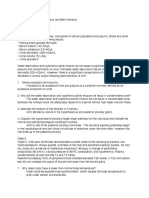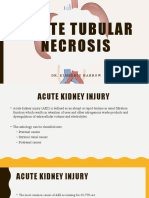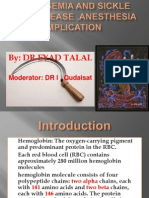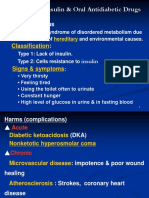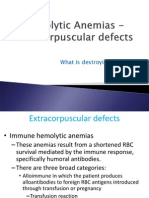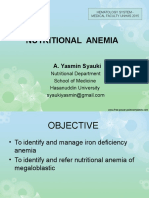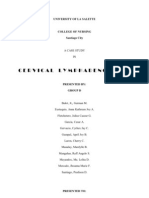Thyroid Hormones and Anti
Thyroid Hormones and Anti
Uploaded by
NishaHasanCopyright:
Available Formats
Thyroid Hormones and Anti
Thyroid Hormones and Anti
Uploaded by
NishaHasanOriginal Description:
Copyright
Available Formats
Share this document
Did you find this document useful?
Is this content inappropriate?
Copyright:
Available Formats
Thyroid Hormones and Anti
Thyroid Hormones and Anti
Uploaded by
NishaHasanCopyright:
Available Formats
Thyroid Hormones and Anti-Thyroid Drugs
Synthesis, storage and secretion of thyroid hormones
The thyroid gland secretes 3 hormones
1. Thyroxine (T4)
2. T3
3. Calcitonin
T4 and T3 are essential for normal growth and development whilst also controlling metabolism
Calcitonin regulates calcium levels within the plasma and can be used to treat osteoporosis
Functional unit of a thyroid is the follicle, which consists of a single layer of epithelial cells around a cavity (follicle lumen).
The cavity is filled with thyroglobulin (thick colloid)
Thyroglobulin is a large glycoprotein and each molecule has 115 tyrosine residues
Thyroglobulin is synthesised, glycosylated and then secreted in the follicle lumen where the tyrosine residues are iodinated
A dense blood flow network surrounds the follicles and rate of blood flow through the gland is high in comparison to other
tissues
The main steps involved in synthesis, storage and secretion of thyroid hormone are:
1. Uptake of plasma iodide by follicle cells
2. Oxidation of iodide and iodination of tyrosine residues of thyroglobulin
Iodide uptake is an energy dependant process which occurs against a gradient
Iodide is captured from the blood and moved to the lumen by two transporters: the Na/I symporter (located at the
basolateral surface of thyrocytes) and pendrin (Na/Cl porter in the apical membrane)
The oxidation of iodide and incorporation into thyroglobulin is aided by thyroperoxidase (located on the inner surface of
the cell by the colloid). Reaction requires the presence of hydrogen peroxide as an oxidising agent
Iodination occurs after tyrosine has been incorporated into thyroglobulin.
Tyrosine residues are iodinated first at position 3 to form MIT and then can later be iodinated at position 5 to form DIT.
These molecules are then coupled in pairs. MIT+ DIT forms T3 and DIT + DIT forms T4
Mechanism for coupling is thought to involve a peroxidase system similar to the one used in iodination
The iodinated thyroglobulin of the thyroid forms a large store of thyroid hormone within the gland with a relatively slow
turnover in contrast to other endocrine secretions
Secretion of thyroid hormone
Thyroglobulin is taken up into the follicle cell by endocytosis
Endocytotic vesicles then fuse with lysosomes and proteolytic enzymes which act on thyroglobulin to release T3 and T4
into the plasma
The surplus MIT and DIT are released into the plasma too but are enzymatically degraded the iodine is scavenged for
further use
Regulation of thyroid function
TRH is released from the hypothalamus in response to various stimuli which in turn releases thyroid stimulating hormone (TSH) from
the anterior pituitary
TSH acts on the membrane receptors of the thyroid follicle cells and via a mechanism involving cAMP and PD3 kinase it has a
trophic effect on thyroid cells
o Leads to the increased transcription of iodine transporter genes which would therefore increase uptake of iodine
o Increased synthesis and secretion of thyroglobulin
o Increased production of hydrogen peroxide and increased iodination of thyroglobulin
o Endocytosis and proteolysis of thyroglobulin
o Secretion of T3 and T4
o Blood flow through the gland
TSH production is regulated via negative feedback of the thyroid hormones (T3 being more active than T4). The peptide
somatostatin also reduces TSH production
Plasma iodide concentrations also influence thyroid function. Reduced levels of iodine intake lead to reduced plasma iodide
concentration and therefore reduced hormone production and an increase in TSH levels and vice versa
Hyperthyroidism
Also referred to as thyrotoxicosis
XS activity of thyroid hormones resulting in a higher metabolic rate, increased body temp, weightloss and tachycardia
There are two types of thyrotoxicosis: diffuse toxic goitre (graves disease) and toxic nodular goitre
Diffuse toxic goitre organ specific autoimmune disease caused by autoantibodies targeting TSH which induces increased
thyroid production. There is also increased sensitivity to catecholamines
Toxic nodular goitre caused by benign neoplasm or adenoma
Drugs for hyperthyroidism:
Radioiodine given orally, taken up by the thyroid gland in a similar mechanism to normal iodine and damages cells via emitting
radiation to prevent further thyroid hormones being produced
Thioureylenes (e.g carbamipazole) decreases synthesis of thyroid hormones via inhibition of thyroperoxidase and therefore
reduces the iodination of thyroglobulin
Iodine given orally in huge doses to transiently reduce thyroid hormone secretion and reduce vascularity of the gland
Hypothyroidism
Decreased activity of the thyroid
Also referred to as myxoedema
Immunological in origin low metabolic rate, bradycardia, slow speech, lethargy and sensitivity to cold are symptoms
Hashimotos thyroiditis is caused by an immune response mounted against thyroglobulin
Treatment of thyroid tumours with radioiodine is also often a cause of hypothyroidism
The only effective treatment (if not caused by iodine deficiency) is to administer the thyroid hormones themselves during replacement
therapy.
Drugs for Hypothyroidism:
Levothyroxine orally administered. Has the actions of thyroxine as its a synthetic compound which resembles
structural similarities
Liothyronine has all the actions of endogenous tri-iodothyronine (T3) and is administered via IV
You might also like
- Reproduction AtfDocument85 pagesReproduction AtfGheorghe AdrianNo ratings yet
- Assignment 4Document8 pagesAssignment 4api-328441669100% (1)
- Endocrine DisordersDocument5 pagesEndocrine DisordersBilly Ray VillanuevaNo ratings yet
- Sideroblastic AnemiaDocument8 pagesSideroblastic AnemiaIslam Ahmady MohamedNo ratings yet
- Parathyroid GlandDocument3 pagesParathyroid GlandElla OrtegaNo ratings yet
- Diabetes MellitusDocument75 pagesDiabetes MellitusIndika KarunamuniNo ratings yet
- Pituitary TumorsDocument6 pagesPituitary Tumorsapi-271668042No ratings yet
- Thyroid and Its Functions: DR Raghuveer ChoudharyDocument61 pagesThyroid and Its Functions: DR Raghuveer ChoudharyPhysiology by Dr RaghuveerNo ratings yet
- Immune Thrombocytopenia (Second Option)Document16 pagesImmune Thrombocytopenia (Second Option)Fein MalricNo ratings yet
- Anatomy and Physiology of ThyroidDocument23 pagesAnatomy and Physiology of ThyroidPonnan DasaiyanNo ratings yet
- Repro Costanzo NotesDocument11 pagesRepro Costanzo NotesAbeebs SalahouNo ratings yet
- Thyroid DisordersDocument67 pagesThyroid DisordersMA 09No ratings yet
- Acute Tubular NecrosisDocument60 pagesAcute Tubular NecrosisYedesney C. LinaresNo ratings yet
- Disorders of Growth and DevelopmentDocument52 pagesDisorders of Growth and DevelopmentMaria Hudson100% (1)
- Thyroid Function TestDocument28 pagesThyroid Function TestDhinesh Muthusamy100% (1)
- Drugs For GUTDocument11 pagesDrugs For GUTAyesha LiaqatNo ratings yet
- By: DR Eyad Talal: Moderator: DR I - QudaisatDocument55 pagesBy: DR Eyad Talal: Moderator: DR I - QudaisatEyad AbdeljawadNo ratings yet
- HyperthyroidismDocument54 pagesHyperthyroidismAsiah JelitaNo ratings yet
- Hormon GDSDocument23 pagesHormon GDSBRI KUNo ratings yet
- USMLE Step 2 (3) - Thyroid DiseaseDocument4 pagesUSMLE Step 2 (3) - Thyroid DiseaseMavra zNo ratings yet
- Hormone Feedback LoopsDocument6 pagesHormone Feedback LoopsSylheti BabaNo ratings yet
- ACUTE PHASE PROTEINS FinalDocument29 pagesACUTE PHASE PROTEINS FinalMorgan100% (1)
- Iron Metabolism: DR Mukhtiar BaigDocument58 pagesIron Metabolism: DR Mukhtiar BaigdrmukhtiarbaigNo ratings yet
- BilirubinDocument40 pagesBilirubinAnisetiyowatiNo ratings yet
- Chapter 34 Insulin & Oral Antidiabetic DrugsDocument24 pagesChapter 34 Insulin & Oral Antidiabetic DrugsIlham RamadhanNo ratings yet
- Thyroiddisease 190216062020Document42 pagesThyroiddisease 190216062020Manikandan Vp100% (1)
- VASCULITISDocument79 pagesVASCULITISSol CamusNo ratings yet
- Amenorrhea and Oligomenorrhea With Hyperprolactinemia and GalactorrheaDocument8 pagesAmenorrhea and Oligomenorrhea With Hyperprolactinemia and GalactorrheatommysuharnataNo ratings yet
- Therapeutics: Thyroid DisordersDocument24 pagesTherapeutics: Thyroid DisordersSharas FarhadNo ratings yet
- Thyroid and InfertilityDocument36 pagesThyroid and InfertilitySairindri SahooNo ratings yet
- Thyroid DisorderDocument19 pagesThyroid DisorderBudi AthAnza SuhartonoNo ratings yet
- Renal - PathDocument23 pagesRenal - PathKimberly KanemitsuNo ratings yet
- Hyperthyroidsm: EpidemiologyDocument6 pagesHyperthyroidsm: EpidemiologyEllieNo ratings yet
- Actions of Thyroid Hormone: Dr. Ayisha Qureshi Assistant Professor MBBS, MphilDocument41 pagesActions of Thyroid Hormone: Dr. Ayisha Qureshi Assistant Professor MBBS, MphilJyoti ChadhaNo ratings yet
- Lecture 10 - Hemolytic Anemias - Extracorpuscular DefectsDocument28 pagesLecture 10 - Hemolytic Anemias - Extracorpuscular DefectsArif MaulanaNo ratings yet
- What Is Destroying This RBC?Document28 pagesWhat Is Destroying This RBC?Putri Azka RinandaNo ratings yet
- Thyroid Disorders in ElderlyDocument16 pagesThyroid Disorders in ElderlyYayatRuslanNo ratings yet
- Course: Medical Surgical Nursing Ii Course Code: NSC 322 Topic: Leukamia Lecturer: Mrs Chukwu Date: Tuesday, 7Th June, 2022Document13 pagesCourse: Medical Surgical Nursing Ii Course Code: NSC 322 Topic: Leukamia Lecturer: Mrs Chukwu Date: Tuesday, 7Th June, 2022Leo D' GreatNo ratings yet
- 6.1 Pitutary DisorderDocument32 pages6.1 Pitutary Disordersiltanu awokeNo ratings yet
- Gout N Osteoporasis GaganDocument33 pagesGout N Osteoporasis GaganGaganpreet Kaur0% (1)
- Acute Lymphoblastic Leukemia (ALL)Document14 pagesAcute Lymphoblastic Leukemia (ALL)Med PhuongNo ratings yet
- GoitreDocument6 pagesGoitreJohn Vladimir A. BulagsayNo ratings yet
- Thyrotoxicosis: Presenter: Emiacu Kenneth Facilitator: Dr. Freddie KibengoDocument35 pagesThyrotoxicosis: Presenter: Emiacu Kenneth Facilitator: Dr. Freddie KibengoNinaNo ratings yet
- Thyroid Disease in PregnancyDocument53 pagesThyroid Disease in PregnancyTee Wei SianNo ratings yet
- Acute Inflammation of Abdominal TigerDocument100 pagesAcute Inflammation of Abdominal TigerJu Lie AnnNo ratings yet
- Anti Thyroid AntibodyDocument16 pagesAnti Thyroid AntibodyFritz HaryadiNo ratings yet
- Nutritional Anemia-Apr 2015Document110 pagesNutritional Anemia-Apr 2015MJ PutraNo ratings yet
- 20 Questions On AtherosclerosisDocument5 pages20 Questions On AtherosclerosisPaul WestonNo ratings yet
- Disorders of Adrenal GlandDocument43 pagesDisorders of Adrenal GlandadinayNo ratings yet
- Lecture 29 30 Thyroid TherapeuticsDocument3 pagesLecture 29 30 Thyroid TherapeuticsAhmed MashalyNo ratings yet
- Lesson 6 Thyroid and Antithyroid DrugsDocument28 pagesLesson 6 Thyroid and Antithyroid DrugstheintrovNo ratings yet
- Disorders of Endocrine System: Prof. J. Hanáček, MD, PHDDocument66 pagesDisorders of Endocrine System: Prof. J. Hanáček, MD, PHDjerinthomasrajanNo ratings yet
- Hyperprolactine MIA: Prepared By: Daryl S. AbrahamDocument15 pagesHyperprolactine MIA: Prepared By: Daryl S. AbrahamBiway RegalaNo ratings yet
- Portal Hypertension Pathogenesis and Diagnosis PDFDocument15 pagesPortal Hypertension Pathogenesis and Diagnosis PDFLizeth GirónNo ratings yet
- Prostate GlandsDocument3 pagesProstate GlandsDragan PetrovicNo ratings yet
- Parathyroid Glands: Serum PTH Levels Are Inappropriately Elevated For The LevelDocument4 pagesParathyroid Glands: Serum PTH Levels Are Inappropriately Elevated For The LevelNada MuchNo ratings yet
- Group 6-B2 - Telomerase, Aging and CancerDocument76 pagesGroup 6-B2 - Telomerase, Aging and CancerJohn Michael Vicente100% (1)
- Pharmacology of Thyroid HormonesDocument56 pagesPharmacology of Thyroid HormonesDr.U.P.Rathnakar.MD.DIH.PGDHMNo ratings yet
- Hereditary Spherocytosis, A Simple Guide To The Condition, Diagnosis, Treatment And Related ConditionsFrom EverandHereditary Spherocytosis, A Simple Guide To The Condition, Diagnosis, Treatment And Related ConditionsNo ratings yet
- LP in Grade 5 ScienceDocument9 pagesLP in Grade 5 SciencemacahigcharmainepadualNo ratings yet
- Hands On-Equine Craniosacral NHMDocument4 pagesHands On-Equine Craniosacral NHMapi-237342656100% (1)
- Second Prelim ExaminationDocument1 pageSecond Prelim Examinationjoan marie PeliasNo ratings yet
- Abdominal Compartment SyndromeDocument12 pagesAbdominal Compartment SyndromeAltus GoldenNo ratings yet
- REPRODUCTIVE SYSTEM DLP (AutoRecovered)Document6 pagesREPRODUCTIVE SYSTEM DLP (AutoRecovered)Roshieko Dennise LaraNo ratings yet
- Anatomy and Function of The Vagina and Pelvic MusclesDocument32 pagesAnatomy and Function of The Vagina and Pelvic MusclesleniucvasileNo ratings yet
- FLGX113 SU3.3 and SU 3.4Document60 pagesFLGX113 SU3.3 and SU 3.4Jason Van Den HeeverNo ratings yet
- MRC Escala para Evaluar Debilidad Muscular Por Grupos MuscularesDocument1 pageMRC Escala para Evaluar Debilidad Muscular Por Grupos MuscularesMileniNo ratings yet
- Physio SeminarDocument21 pagesPhysio SeminarNandini BhargavaNo ratings yet
- Immunodeficiency DisordersDocument3 pagesImmunodeficiency DisordersMohan VamsiNo ratings yet
- 1bds PDocument16 pages1bds PS ArtNo ratings yet
- Lab Output For Blood (Human Anatomy and Physiology)Document8 pagesLab Output For Blood (Human Anatomy and Physiology)Dayledaniel Sorveto0% (1)
- Childrens FBC Reference Ranges PDFDocument1 pageChildrens FBC Reference Ranges PDFWarisatul Imam LubisNo ratings yet
- Patologi Anatomi - FNAB 1Document64 pagesPatologi Anatomi - FNAB 1amieNo ratings yet
- SpermatogenesisDocument27 pagesSpermatogenesisSabio DenmenNo ratings yet
- Semi-Detailed Lesson Plan For Grade 9 ScienceDocument4 pagesSemi-Detailed Lesson Plan For Grade 9 ScienceJeffrey FloresNo ratings yet
- Original Article: A Guide To Histomorphological Evaluation of Intestinal Inflammation in Mouse ModelsDocument21 pagesOriginal Article: A Guide To Histomorphological Evaluation of Intestinal Inflammation in Mouse ModelsOUR STORYNo ratings yet
- Gas Exchange in Humans: Multiple-Choice QuestionsDocument56 pagesGas Exchange in Humans: Multiple-Choice QuestionsZ s2021 4C Ma Ka Ki Margaret 4C16No ratings yet
- Exploring The Development of Dendritic Cell-Based Cancer Vaccines With A Focus On Cancer ResearchDocument9 pagesExploring The Development of Dendritic Cell-Based Cancer Vaccines With A Focus On Cancer ResearchIJAR JOURNALNo ratings yet
- Elektrofisiologi Jantung: Denny AgustiningsihDocument20 pagesElektrofisiologi Jantung: Denny AgustiningsihBayu Zeva WirasaktiNo ratings yet
- 2017 Growing Teratoma SyndromeDocument5 pages2017 Growing Teratoma SyndromeOscar GarciaNo ratings yet
- Anatomy and Physiology SummaryDocument8 pagesAnatomy and Physiology SummaryAssaf KamaraNo ratings yet
- Herculean Arms GeneticsDocument2 pagesHerculean Arms Geneticssykmos65No ratings yet
- Lewis Book ChapterDocument24 pagesLewis Book ChapterHarjotBrar100% (1)
- Final Case CervicalDocument25 pagesFinal Case CervicalGerman BalotNo ratings yet
- Review of Concepts (Digestive System) - Crossword LabsDocument3 pagesReview of Concepts (Digestive System) - Crossword Labssamantha.g.eatonNo ratings yet
- Tone AbnormalitiesDocument32 pagesTone AbnormalitiespuchioNo ratings yet
- 3.4 Process of Absorption and Transportation of Digested Food and DefecationDocument9 pages3.4 Process of Absorption and Transportation of Digested Food and DefecationFrank ZachNo ratings yet
- 2.1.2 WS ReusableDocument2 pages2.1.2 WS Reusableharittha.param33No ratings yet

